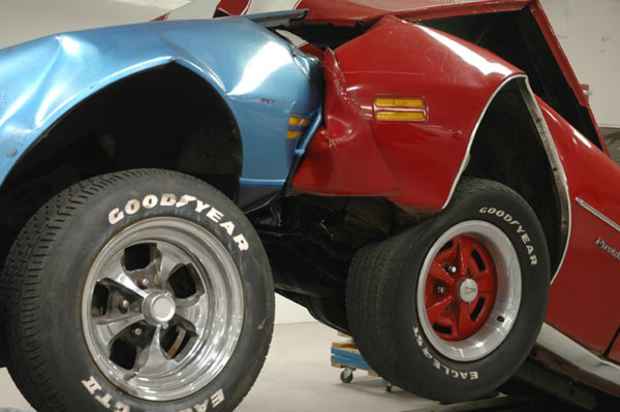Jonathan Schipper "Irreversibility"
The Boiler

This event has ended.
Jonathan Schipper's third solo exhibition at Pierogi will include recent large-scale sculpture and installation including: “Measuring Angst,” a beer bottle which is thrown across a forty-five foot room, smashes against a wall and attempts to reassemble itself; and, “The Slow Inevitable Death of American Muscle,” a live, head-on collision which takes place in slow-motion over the course of the exhibition.
“The Slow Inevitable Death of American Muscle” (exhibited in New York for the first time) is a collision between two actual cars, a Camaro and a Firebird, both General Motors models. Developed prior to the recent collapse of the auto manufacturer, and referring to more than the decline of America’s auto industry, this work is more relevant than ever. A specially designed gear system allows the artist to determine the duration of the crash so that over the course of six weeks the two cars will be slowly but forcibly moved together until they begin to crush one another. (Made with engineering by Karl Biewald.)
In “Measuring Angst,” a beer bottle is thrown across the room and travels some forty feet before hitting the wall and breaking apart. The bottle moves on a steel track and is computer controlled with robotic hardware, which allows the cycle of motions to begin and end over and over again.
Both of these works engage ideas of time, motion, and change. They demonstrate violent and destructive acts slowed down in the way that time and action seems to slow during critical events. In the controlled environment of the gallery the events can be examined in a way that they never could be in real time. The effects of force applied to the cars become visible as it works on each part. Fragments of the bottle rotate and twist as they spin away. After the cars are crumpled they cannot be returned to their original shape or function. In “Measuring Angst,” the artist attempts to bring the broken bottle pieces back together but they can never quite reconstruct. As the title of an earlier Schipper sculpture notes, this reveals an “inherent beauty in a failed attempt to reconstruct.”
In the notion of irreversibility in physics (specifically thermodynamics), theoretically, reversibility is possible, but real world natural systems are so complex that physical changes become irreversible—something is changed and can never be the same again. In the larger realm, ideas of irreversibility are “applied to a wide assortment of...questions, including overuse of antibiotics, genetic modification of food, avian flu, and climate change.” (Cass R. Sunstein, Harvard University) Here, Schipper relies on science and physics rather than faith to attempt to examine and explain the world around us.
Media
Schedule
from May 15, 2009 to June 28, 2009